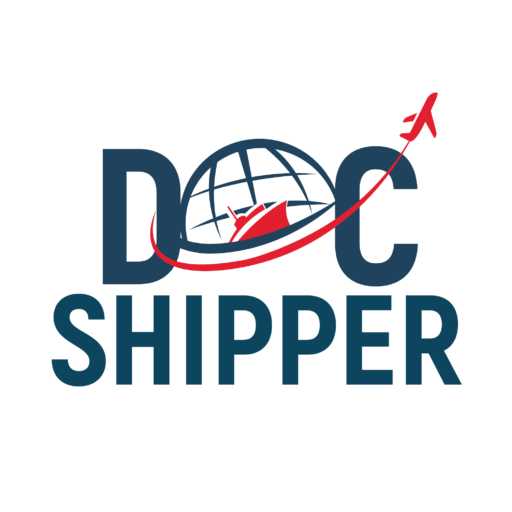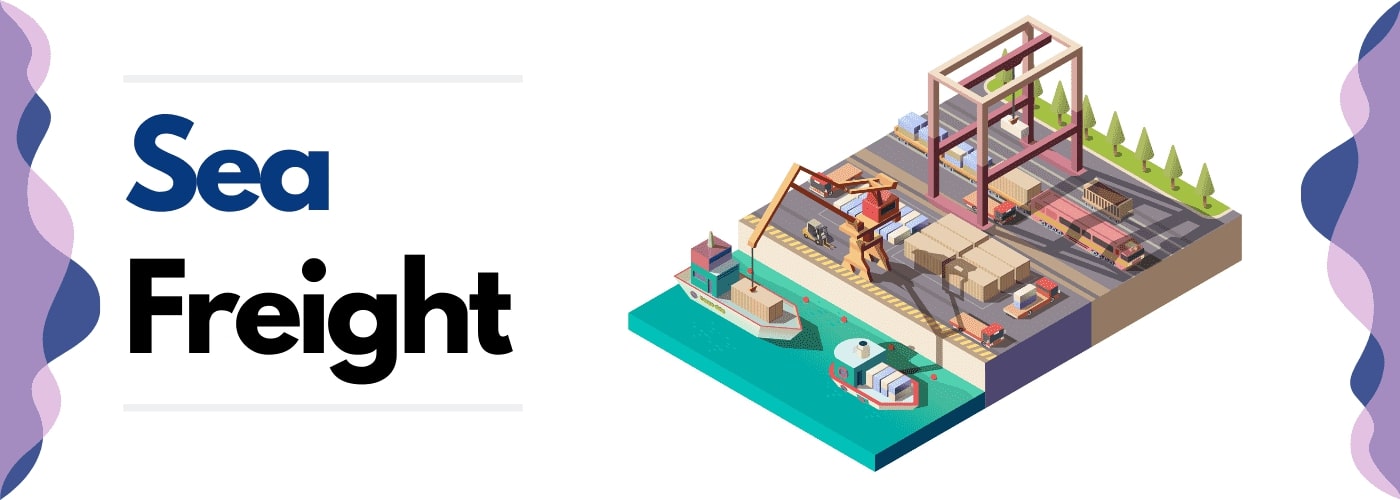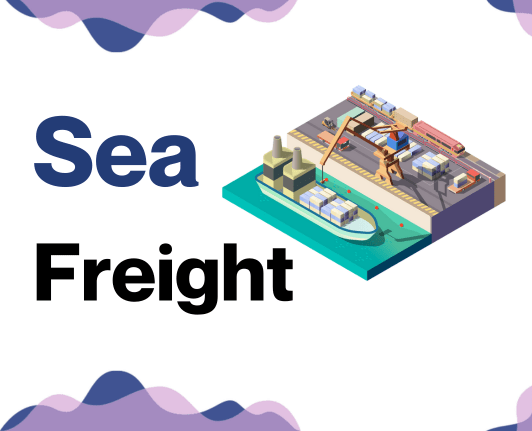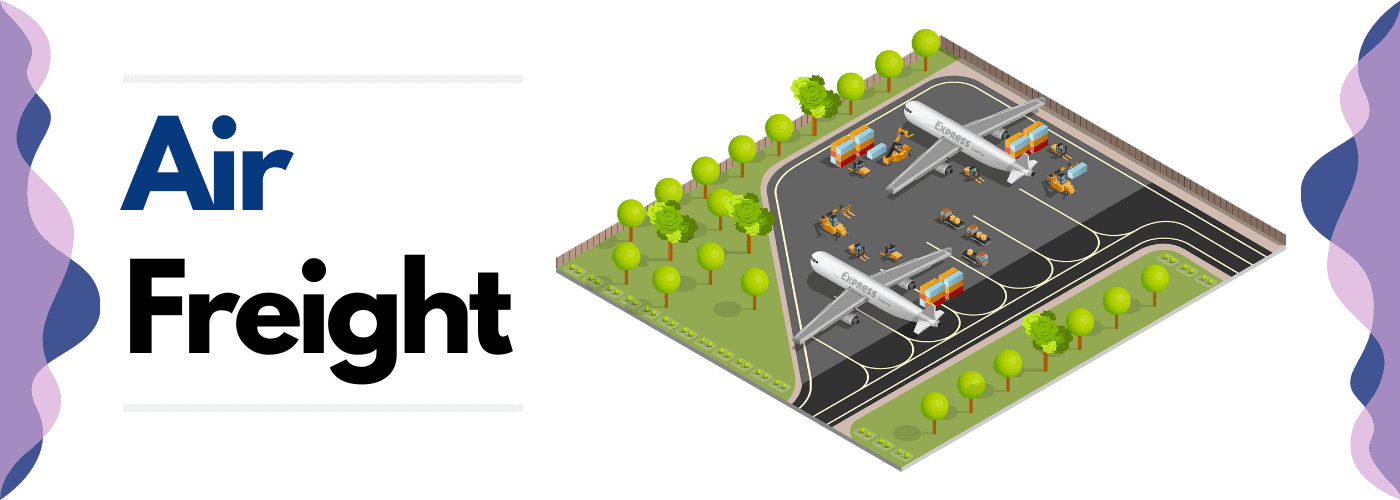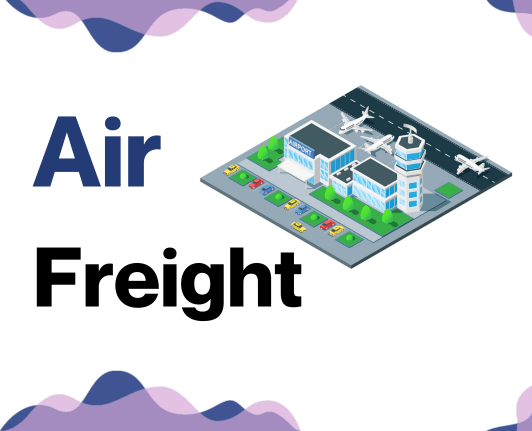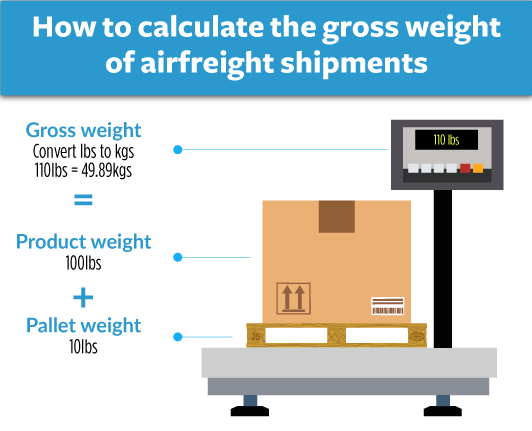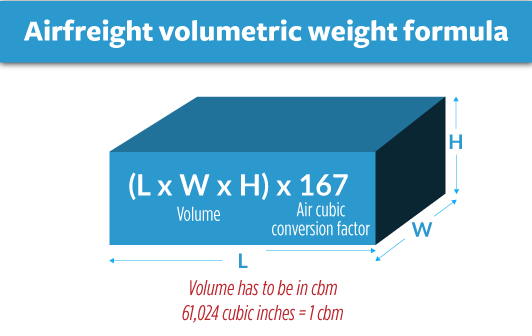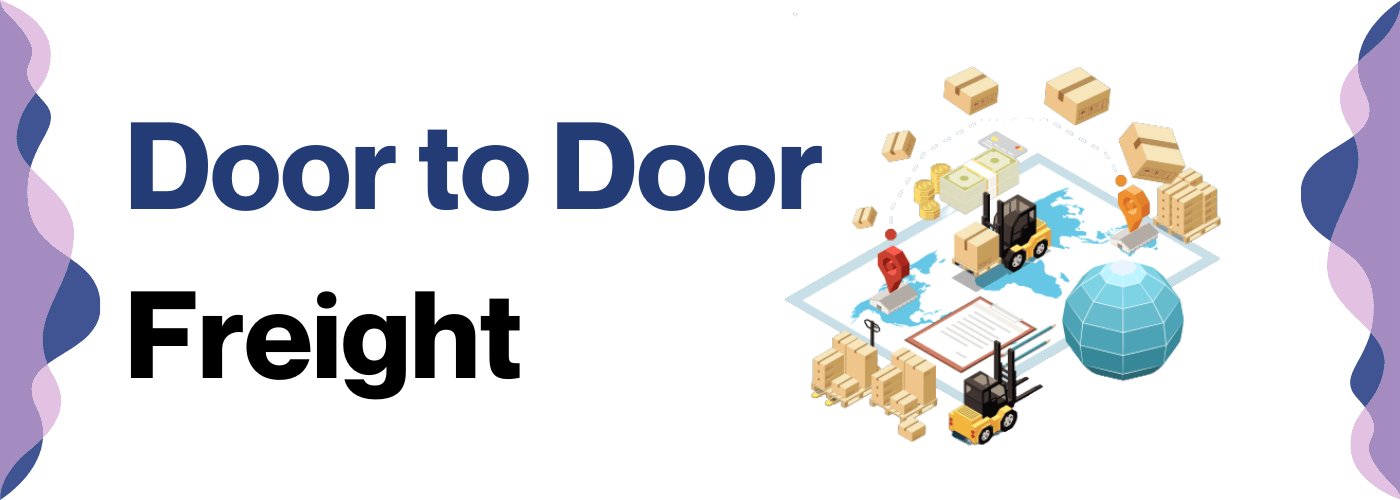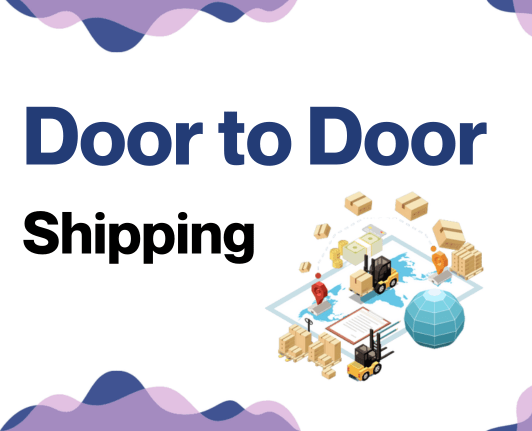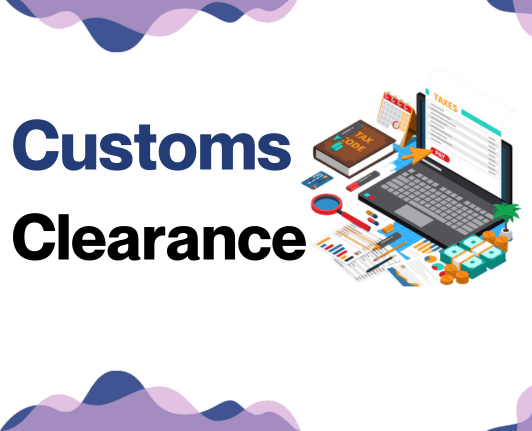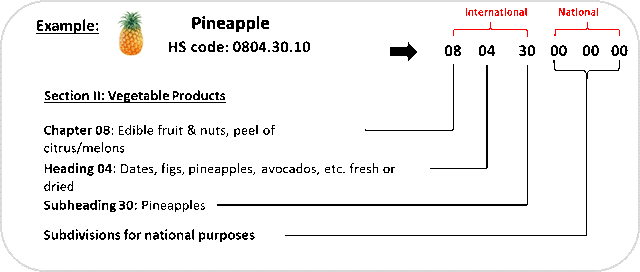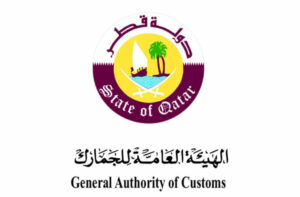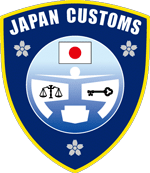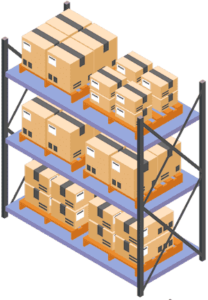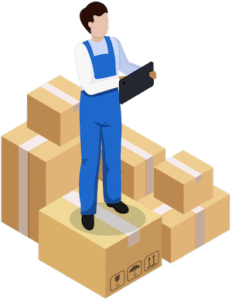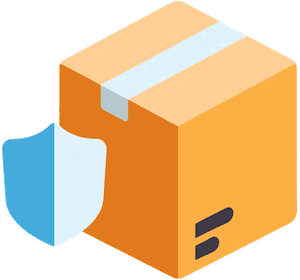Moving cargo from Qatar to Japan isn't just a hop, skip and a jump across the continent - it's a dance with intricacies and challenges like deciphering complex rates, gauging transit times, and complying with ever-varying customs policies. This guide aims to take you comprehensively through every turn of this dance. We'll delve into diverse freight options, whether you're considering air, sea, road or rail. We dedicate a considerable portion to the rigmaroles of customs clearance, duties, taxes, and share unique advice tailored to the needs of businesses. If the process still feels overwhelming, let DocShipper handle it for you! As seasoned chaperons in the international freight arena, we handhold you through every step, turning the delicate imbalance of challenges into a triumphant pirouette of success.
Which are the different modes of transportation between Qatar and Japan?
When deciding how to ship goods from the blazing sun of Qatar to the cherry blossom landscapes of Japan, you have two main options - air or sea. Picture a giant container ship cruising over the miles of the ocean; it's slow but budget-friendly. Now imagine a plane, swiftly soaring among the clouds; it's fast but pricier. Think about your shipment's nature and urgency. If it's heavy machinery, the slow sea voyage may be best. But if it's time-sensitive electronics, the speed of the plane is worth the ticket. The right transport can be the compass guiding your goods safely home.
How can DocShipper help?
Shipping between Qatar and Japan? Let DocShipper lighten your load. We handle complex logistics, manage customs clearance, and ensure your goods travel safely – whether by air, sea, road, or rail. Why stress about moving goods when we can pave the way? Reach out to us for a free estimate within 24 hours, or chat with our consultants at no cost to you.
DocShipper Tip: Sea freight might be the best solution for you if:
- You're dealing with hefty quantities or large-scale goods. Sea freight is your go-to for maximizing space without stretching your budget.
- Your cargo doesn't have an urgent deadline, as sea freight typically has longer transit times compared to air or rail.
- Your shipping routes are between major ports, allowing you to leverage the extensive global network of sea shipping lanes.
Sea freight between Qatar and Japan
Oceans apart yet linked by commerce, Qatar and Japan have a thriving trade relationship, partly anchored by the strategic cargo ports of Hamad and Yokohama, acting as lifeblood connectors to their key industrial centers. Think of these ports as busy train stations, passengers as exports and imports, and trains as freight ships. They make ocean shipping a riveting adventure for high-volume goods—not the cagey hare, but the steady, economical tortoise of the transport world.
Now, let's dust off the real-world puzzles you face as shippers. Sea freight between these nations can feel like solving a Rubik's cube - twists, turns, and inevitable setbacks. Misunderstandings around customs clearance, duties, and other details, often land you in a maze filled with time-consuming and costly errors. But fear not, the upcoming sections are your GPS, guiding you through the labyrinth, spotlighting best practices, and bringing overlooked specifications into sharp focus. As the saying goes, forewarned is forearmed. Let's arm you with knowledge.
Main shipping ports in Qatar
Hamad Port
Location and Volume: Ideally situated in Umm Al Houl, Qatar, Hamad Port plays a major role in facilitating the in-and-out flow of the international trade, spanning an astounding 28.5 square kilometres. The port's annual handling capacity is impressively large, with a shipping volume of over 7.8 million TEU.
Key Trading Partners and Strategic Importance: The Port of Hamad harbours a variety of trading relationships with key international partners and is a significant facilitator of Qatar's trade with countries like China, the U.S., and India. It is recognized as a modern gateway to Qatar and the world, connecting to three continents.
Context for Businesses: If you're aiming to penetrate Middle Eastern markets or enhance your delivery speed to these markets, Hamad Port could become a crucial keystone in your strategy due to its modern facilities, its geopolitical location making it connect seamlessly to various strategic trading routes, and its broad range of terminals designed to handle a multitude of goods.
Ras Laffan Port
Location and Volume: Located to the north of Doha, Ras Laffan Port is one of the most important ports in Qatar, spanning over 110 square kilometers. Designed to handle goods related to the oil and gas industry, it has a smaller but highly specialized shipping volume.
Key Trading Partners and Strategic Importance: Ras Laffan primarily facilitates trade for the energy industry. Its central focus on gas and petroleum products makes it extremely significant to countries heavily invested in the energy sector, such as Japan, South Korea, and India.
Context for Businesses: If your business operates within the energy industry, specifically dealing with gas and petroleum products, Ras Laffan Port would be a fundamental part of your go-to-market strategy. Its state-of-the-art and specialized terminals can accommodate an array of energy-related goods, ensuring smooth and efficient transport of your commodities.
Mesaieed Port
Location and Volume: Positioned on the eastern coast of Qatar, Mesaieed Port is an industrial port of high traffic. Integrated with the major industrial city of Qatar, it accommodates a substantial shipping volume mainly comprising bulk cargo and general cargo like aluminium, steel, and petrochemicals.
Key Trading Partners and Strategic Importance: Mesaieed's major trading partnership lies within the Gulf Cooperative Council (GCC) countries, and it holds significant strategic importance due to its closeness to major industries and transport routes.
Context for Businesses: Mesaieed Port might be a crucial element to your logistics if your business deals with heavy industrial goods, such as aluminium, steel, or petrochemicals. Its convenient location and integrated operations with major industries ensure streamlined and efficient shipping procedures, potentially lowering your logistics costs.
Main shipping ports in Japan
Port of Yokohama:
Location and Volume: Located in Yokohama city, right next to Tokyo, this port is essential for trading due to its proximity to the capital of Japan, with a shipping volume of approximately 3 million TEU.
Key Trading Partners and Strategic Importance: Some of its key trading partners include China, United States, and Australia. It's also used as a major cruise port, attracting many tourists each year.
Context for Businesses: If you’re looking to tap into the Japanese market, the Port of Yokohama's well-connected shipping routes could offer an excellent entry point for your goods.
Port of Kobe
Location and Volume: Nestled in the city of Kobe, this busy container port manages a shipping volume of around 2.4 million TEU.
Key Trading Partners and Strategic Importance: With close ties to China, South Korea, and Taiwan, the port’s strategic importance cannot be understated.
Context for Businesses: If your business requires frequent shipments to East Asia, a port like Kobe, which is a major hub for East Asia-western North America routes, may be essential for your logistics.
Port of Tokyo
Location and Volume: Situated in Tokyo Bay, this port manages Japan's busiest export hub with a shipping volume of 4.3 million TEU.
Key Trading Partners and Strategic Importance: The Port of Tokyo has significant trade relations with China, the US, and South Korea.
Context for Businesses: This port is particularly suitable for businesses focusing on electronic goods, providing seamless access to vast consumer markets like China and the U.S.
Port of Nagoya
Location and Volume: Located in Ise Bay, off the Pacific Coast of Japan, the Port of Nagoya is the largest and busiest port in Japan, handling a shipping volume of over 9 million TEU.
Key Trading Partners and Strategic Importance: The port primarily trades with China, the US, and Australia, and it serves as a primary export port for Japan's automobile industry.
Context for Businesses: Given its role in the automobile trade, the Port of Nagoya may be an indispensable element of your supply chain if you're in the automobile sector.
Port of Osaka
Location and Volume: Located in Osaka Bay, this port manages a significant shipping volume of about 2.2 million TEU.
Key Trading Partners and Strategic Importance: The Port of Osaka has robust ties with China, the U.S., and Taiwan, and it functions as an integral part of Japan's domestic trade network.
Context for Businesses: For businesses focusing on domestic distribution in Japan, the Port of Osaka is a key node in Japan's logistics network you will likely find indispensable.
Port of Hakata
Location and Volume: Found in Fukuoka city on the island of Kyushu, this port is essential as a gateway to Asian markets, with a shipping volume of nearly 1 million TEU.
Key Trading Partners and Strategic Importance: Noteworthy trading partners include China, South Korea, and Taiwan.
Context for Businesses: If you're looking to extend to Southeast Asian markets, the Port of Hakata could be a critical part of your logistics, given its strategic location and shipping routes.
Should I choose FCL or LCL when shipping between Qatar and Japan?
Shipping goods between Qatar and Japan? One of the key decisions you'll face is choosing between Full Container Load (FCL) and Less than Container Load (LCL), or consolidation. This choice affects not just your costs, but also transit times and, ultimately, your operation's efficiency. Let's dive into these sea freight options to help you make the best decision for your specific needs, ensuring the smooth sailing of your cargo. Be prepared to gain insights into these unique methods, and most importantly, how to select the perfect route for your shipment!
LCL: Less than Container Load
Definition: Less than Container Load (LCL) shipping, often known by its acronym LCL, is a method of transporting goods that aren't enough to fill an entire container, combined with other shippers' cargo.
When to Use: If your cargo volume is less than 15 cubic meters (CBM), the LCL option may prove suitable. It's often the go-to choice for its flexibility and affordability when dealing with low volume shipments that don't demand the use of a full container.
Example: Consider a business that produces artisanal ceramics in Doha, Qatar, needs to ship 12 CBM of assorted pottery designs to a boutique retailer in Tokyo, Japan. This volume is inadequate to fill a whole container, so going with LCL shipping would be the profitable and sensible choice.
Cost Implications: The cost of LCL shipping is calculated per volume—unlike Full Container Load (FCL), where you pay for the entire space regardless of usage. It's important to note, though, that the cost per CBM tends to be higher for an LCL shipment than for FCL. This makes LCL typically more cost-effective only until you exceed the 13/14/15 CBM range in your lcl freight.
FCL: Full Container Load
Definition: FCL, or Full Container Load, is a type of sea freight where you rent the entire container - often a 20'ft or 40'ft length - exclusively for your goods.
When to Use: FCL shipping is excellent for larger shipments, ideally those exceeding 13/14/15 cubic meters (CBM). This is because it's cost-effective for high-volume cargo and enhances security as the container stays sealed from origin (Qatar) to destination (Japan).
Example: Consider an automotive parts manufacturer shipping 40 CBM of goods. Choosing FCL, they can secure a 40'ft container solely for their shipment, ensuring safety and reducing unit cost.
Cost Implications: The fcl shipping quote typically includes a flat rate per container, disregarding the weight or volume of goods inside. This makes it considerably cheap for high-volume shipments. However, while the FCL container cost may appear steep on face value, breaking it down per unit or per CBM can demonstrate its value. It's worth noting the other associated costs such as customs clearance or handling fees at both the origin and destination ports.
Unlock hassle-free shipping
Shipping from Qatar to Japan? Let DocShipper make it hassle-free for you! Our ocean freight experts consider parameters like cargo size, time-sensitivity, and budget to guide you between consolidation and full container shipping. Say goodbye to complex shipping decisions, our expertise is at your disposal. Contact us today for a free estimation, and let's simplify your shipping together!
How long does sea freight take between Qatar and Japan?
Sea freight between Qatar and Japan usually takes around 30 to 40 days. However, the actual transit time can vary depending on various factors such as the specific port of loading and unloading, the weight and nature of the goods being transported. To get a more accurate estimate, it's recommended to contact a freight forwarder like DocShipper for a customized quote.
| Port in Qatar | Port in Japan | Average Transit Time (Days) |
| Port of Doha | Port of Tokyo | 40 |
| Port of Masaieed | Port of Yokohama | 36 |
| Port of Ras Laffan | Port of Nagoya | 38 |
| Port of Al Ruwais | Port of Osaka | 42 |
How much does it cost to ship a container between Qatar and Japan?
The complexity of ocean freight rates may leave you guessing about shipping costs from Qatar to Japan. Here's a ballpark: expect a broad range, as several aspects play their parts. This includes your Points of Loading and Destination, selected shipping carrier, nature of the consignment, and the inherent monthly market fluctuations. Can we hand you an exact figure now? Unfortunately, no. But worry not, each shipment is unique, and so are you! Our team of shipping specialists dives deep into the details, quoting tailored rates for every client. You're not just a shipping order to us; you're a partner in achieving efficient and cost-effective logistics!
Special transportation services
Out of Gauge (OOG) Container
Definition: An OOG container, also known as Out of Gauge container, is a special shipping container required for goods that exceed standard shipping measurements.
Suitable for: It's ideal for transporting oversized items like machinery parts, industrial equipment, and large scale construction materials.
Examples: Can be used to transport large turbine parts from Qatar to Japan for a wind energy project.
Why it might be the best choice for you: If your items are too big to fit in the conventional containers but you still want the solidity and protection of a container, the OOG container could be your solution.
Break Bulk
Definition: The break bulk method involves separating or 'breaking' bulk goods into individual units for transportation.
Suitable for: Perfect for oversized or awkward shaped goods that cannot be transported in standard containers.
Examples: Consider break bulk for a shipment of yachts from Qatar to Japan.
Why it might be the best choice for you: By opting for break bulk, you’ll gain more flexibility for your large, awkwardly shaped items.
Dry Bulk
Definition: Dry bulk shipping refers to transportation of large-scale, loose cargo loads like grain and coal.
Suitable for: Bulk products such as raw materials, including grains or minerals.
Examples: Transporting large quantities of construction sand from Qatar to Japan.
Why it might be the best choice for you: If you’re shipping vast volumes of loose, dry goods, this option could lead to cost and time efficiencies.
Roll-on/Roll-off (Ro-Ro)
Definition: Ro-Ro is a vessel designed to carry wheeled cargo such as cars, trucks, semi-trailer trucks, trailers, and railroad cars that Roll-on and Roll-off the ship on their wheels or using a platform vehicle.
Suitable for: Ideal for all types of vehicles and machinery which can be driven on and off the ship.
Examples: Exporting a fleet of trucks from Qatar to Japan.
Why it might be the best choice for you: If you have movable cargo, this could be the most cost-effective and secure transit method.
Reefer Containers
Definition: Reefer containers are refrigerated containers used specifically to transport perishable goods.
Suitable for: Ideal for transporting items requiring temperature control, such as fruits, meat, or pharmaceutical products.
Examples: Perfect for transporting premium Qatari dates to Japan.
Why it might be the best choice for you: If you have temperature-sensitive goods, these containers can maintain the optimal temperature throughout the journey.
In the complex world of international shipping, understanding your options is the first step to success. At DocShipper, we're committed to helping you navigate these choices. Reach out to us for a free shipping quote in less than 24 hours, and let's bring your business closer to its destination.
DocShipper Tip: Air freight might be the best solution for you if:
- You're up against the clock or have a non-negotiable delivery date. Air freight is your fastest bet for meeting tight timelines.
- Your shipment is on the smaller side, falling below 2 CBM. Air freight is particularly well-suited for compact cargo loads.
- Your goods are destined for locations that aren't well-served by maritime or rail options. Air freight expands your reach by connecting you to a vast array of international airports.
Air freight between Qatar and Japan
Imagine you're shipping precious, boutique-quality wristwatches from Qatar to Japan. Speed is critical, right? This is where air freight shines. It’s the Formula 1 of shipping – fast, reliable, and perfect for small but high-value items like our fancy wristwatches. Think of it like your reliable pizza delivery - it costs more, but when it's about delivering your favorite pizza (read: your valuable goods) hot and in time, it's totally worth it!
However, just as ordering extra-large pizzas can leave your pockets lighter, many businesses too stumble when picking air freight. Folks often miscalculate cargo weight or overlook the nitty-gritties of best practices. This, in turn, could skyrocket your costs faster than your cargo takes off. Let's dive in to help you avoid these costly slips!
Air Cargo vs Express Air Freight: How should I ship?
Thinking about shipping goods from Qatar to Japan but overwhelmed by the air freight options? Let's simplify this. Consider air cargo as sharing a commercial flight with other people's parcels, while express air freight means your goods have a private jet all to themselves. In this guide, we'll help you choose wisely based on your specific business needs.
Should I choose Air Cargo between Qatar and Japan?
Considering shipping goods from Qatar to Japan? For over 100/150 kg (220/330 lbs) of cargo, Air cargo, with airlines like Qatar Airways and Japan Airlines, might suit your budget. It offers cost-effectiveness, thanks to the volumetric pricing commonly used, and remarkable reliability. This option also ensures regularity due to the airlines' fixed schedules although it may lengthen transit times. Balancing budget and shipping times can be tricky, air cargos' balance could be just the option you're looking for, especially given its capacity for heavier loads.
Should I choose Express Air Freight between Qatar and Japan?
Express air freight is a specialized service operating on dedicated cargo planes with no passenger interruptions. Ideal for lighter shipments under 1 Cubic Meter (CBM) or 100/150 kg (220/330 lbs), it is a top pick for speed and reliability. Airlines like FedEx, UPS, and DHL are renowned for this service, delivering globally within a few days. If your business requires quick, low-volume shipments from Qatar to Japan, express air freight could be your solution, ensuring your cargo's swift and secure arrival. Consider these factors while deciding your shipment method, ensuring it aligns with your business requirements.
Main international airports in Qatar
Hamad International Airport
Cargo Volume: Hamad International Airport processed 529,436 tonnes of cargo in 2020.
Key Trading Partners: The main trading partners for cargo services in Qatar include China, USA, Austria, Germany, and the Netherlands.
Strategic Importance: Hamad International Airport is strategically positioned in Doha, providing a vital channel for businesses looking to ship goods in and out of the Middle East. As the only commercial airport in Qatar, it services a dense network of destinations with over 3300 flights per week.
Notable Features: Hamad International Airport is equipped with a state-of-the-art cargo terminal, capable of handling 1.4 million tonnes of cargo annually. The airport is also known for its high cargo handling efficiency and precise logistics processes.
For Your Business: Depending on your needs, shipping your goods through Hamad International Airport could mean access to an efficient and globally-connected cargo network. This could be ideal for time-sensitive cargo since the airport's cargo handling efficiency can lend confidence to your supply chain.
Main international airports in Japan
Narita International Airport
Cargo Volume: Narita handled 2.34 million tonnes of cargo in 2019, making it one of the busiest cargo airports in Asia.
Key Trading Partners: Primarily serves trading partners in Asia, North America, and Europe, including China, the United States, and Germany.
Strategic Importance: Narita is a major international hub for Japan, positioned just outside of Tokyo. It offers access to a vast consumer market and opportunities for onward shipping to numerous international destinations.
Notable Features: The airport has modern cargo handling facilities, supports cargo carriers, freight-forwarding agents, and has dedicated areas for perishable and valuable goods.
For Your Business: With a wide range of global connections, Narita can act as an excellent starting point or destination for your goods. Its robust cargo handling infrastructure will ensure the smooth transportation of your products.
Kansai International Airport
Cargo Volume: Kansai processed 852,024 tonnes of cargo in 2020.
Key Trading Partners: Major trade routes are with Asia, primarily China, and the United States.
Strategic Importance: Located on an artificial island in Osaka Bay, Kansai serves the metropolitan area of Osaka, Kobe, and Kyoto, a vital economic center of Japan.
Notable Features: It's a 24-hour operation with advanced cargo handling facilities such as warehousing, storage solutions, and a Free Trade Zone promoting international trade.
For Your Business: Offering round-the-clock operations and access to a critical economic region, Kansai could serve as a vital point in your shipping routes, particularly if your business operates in accordance with a different time zone.
Chubu Centrair International Airport
Cargo Volume: Managed 219,378 tonnes of cargo in 2019.
Key Trading Partners: Mainly trades with other Asian countries, notably China, and the United States.
Strategic Importance: Located in the heart of Japan, it serves as the gateway to the Chubu region, an important industrial zone known for automobiles and ceramics.
Notable Features: The airport has a dedicated cargo terminal, equipped to handle all types of goods, and offers access to a Free Trade Zone.
For Your Business: If you're trading with auto or ceramics industries, Chubu Centrair can significantly streamline your logistics due to its strategic position.
Fukuoka Airport
Cargo Volume: Handled nearly 240,000 tonnes of cargo in 2019.
Key Trading Partners: Key routes are with Asian countries, mainly China, and with the US.
Strategic Importance: Serving the Kyushu region, it's the primary gateway for this area and the closest Japanese airport to other parts of Asia.
Notable Features: Despite its smaller size, it offers a range of services, including cargo handling facilities, express services, and devoted import/export facilities.
For Your Business: If your primary market is within Asia, Fukuoka Airport, due to its proximity, would be a strategic choice, reducing flying time and potentially cutting costs.
Sapporo New Chitose Airport
Cargo Volume: Processed about 114,000 tonnes of cargo in 2018.
Key Trading Partners: Primarily serves Asia, particularly China.
Strategic Importance: It is the main gateway to the northern island of Hokkaido, offering access to its prosperous seafood and agriculture industries.
Notable Features: The airport is equipped with refrigerated warehousing facilities, specialized for the transportation of perishable goods.
For Your Business: If your operations involve perishable goods like seafood or agricultural products, Sapporo New Chitose Airport, with its specialized infrastructure, could be an excellent asset to your shipping strategy.
How long does air freight take between Qatar and Japan?
The average transit time for air freight between Qatar and Japan is typically between 3 to 5 days. It's important to note that this duration is an estimate and can vary depending on several factors. These include the specific airports involved in the transport, the weight of your cargo, and the nature of goods being shipped. For the most accurate transit times, it is highly recommended to consult with a freight forwarding expert like DocShipper.
How much does it cost to ship a parcel between Qatar and Japan with air freight?
Air freight shipping from Qatar to Japan averages between $2 to $5 per kg. However, it's important to note that this is a broad estimate. The final pricing can fluctuate depending on several factors such as the distance from departure and arrival airports, weight and dimensions of parcel, and nature of goods. Our commitment is to offer competitive pricing. With our personalized approach, we provide quotes on a case-by-case basis, ensuring you receive the most cost-effective options. Contact us to obtain a comprehensive quote within 24 hours.
What is the difference between volumetric and gross weight?
Gross weight refers to the total mass of a shipment, including the weight of the cargo itself, any pallets, and packaging. Volumetric weight, on the other hand, is a calculation that reflects the amount of space your cargo takes up on the aircraft's storage area.
Air cargo uses the formula: Length x Width x Height (in cm) / 6000 = Volumetric Weight (kg). For Express Air Freight Services, the calculation slightly differs: Length x Width x Height (in cm) / 5000 = Volumetric Weight (kg).
Let's consider this shipment: a parcel of machine parts measuring 100cm x 50cm x 50cm and weighing 35kg. In Air cargo, the volumetric weight would be 100 x 50 x 50 / 6000 = 41.67kg (almost 92 lbs). For Express Air, the volumetric weight changes to 100 x 50 x 50 / 5000 = 50kg (110.2 lbs). Notice your parcel's gross weight is 35kg (77.16 lbs).
Taking stock, air cargo companies charge freight based on the higher weight between gross and volumetric weight. The strategy ensures the most cost-effective use of transport space. In our example, charges will be based on the volumetric weight, whether shipping via Air cargo or Express Air, since it exceeds the gross weight. This method helps keep freight services efficient by preventing large, light packages from taking up space without proportional payment.
DocShipper tip: Door to Door might be the best solution for you if:
- You prioritize a smooth, hassle-free shipping experience from start to finish. Door-to-door services manage the entire journey, from initial collection to ultimate delivery.
- You appreciate streamlined communication and would rather deal with one person. A dedicated agent is usually assigned to oversee every detail of your door-to-door shipment.
- You want limit the number of touchpoints for your cargo. Door-to-door services reduce the frequency of transitions between various transport methods, thereby lowering the likelihood of damage or loss.
Door to door between Qatar and Japan
Unraveling the matrix of international shipping, let's spotlight 'Door to Door' shipping—a smoother ride for your goods, from Qatar right to Japan. Imagine this: no more juggling between carriers or untangling customs procedures. All your headaches, poof, gone! So, is Door to Door the secret ingredient to seamless, stress-free shipping? Let's roll up our sleeves and dive right in.
Overview – Door to Door
Embracing door-to-door shipping between Qatar and Japan assures you stress-free logistics experience. It simplifies the cross-border shipping process, significantly minimising complexities. Pros? It saves you valuable time by handling everything - from initial pickup to final delivery, ensuring seamless customs clearances. But bear in mind, costs can be higher due to this premium service. Still, it's an investment many DocShipper clients make for peace of mind while navigating complex international laws. Dive deeper into this heavily-popular service and understand why it could be your ideal shipping solution.
Why should I use a Door to Door service between Qatar and Japan?
Ever tried to play a game of tag with shipping containers? Trust me, it's exhausting! That's where Door to Door services for your Qatar-Japan shipping needs come as a game-changer. Here are five compelling reasons you should consider this service:
1. Stress Reducer: Don't pull your hair out over the complex logistics invloved in international transportation. Door to Door service ensures your goods are picked up from the origin and delivered to the destination, doing the tag-game for you!
2. Play It Like a Pro: Urgent shipments require pro-level skills. With Door to Door service, fully equipped professionals orchestrate your deliveries smoothly and punctually, even under the tightest timelines.
3. Confidence in Special Care: Have a shipping container filled with complex cargo? Don't fret! Trust dedicated experts who specialize in handling specific types of goods, ensuring your precious cargo's safety.
4. Never Miss a Beat: Your shipment's progress is tracked till it reaches the final doorstep in Japan - no surprises, no last-minute stress - just your goods, on time, every time.
5. Anywhere-to-Anywhere Convenience: Whether you're shipping from the heart of Doha or a remote area in Qatar, your goods will be transported responsibly until they reach the final destination in Japan. It's like magic, minus the wand!
Choosing a Door to Door service can transform your hectic shipping experience into a walk in the park. See the difference, feel the convenience and give yourself the break you deserve!
DocShipper – Door to Door specialist between Qatar and Japan
Enjoy hassle-free shipping from Qatar to Japan with DocShipper. We handle every detail, from packing your goods to navigating customs and choosing the right shipping method. We're masters of logistics, committed to delivering your goods safely and promptly. An Account Executive will walk you through the entire process. Reach out now for a free estimate within 24 hours, or dial up our consultants for expert advice. Your international shipping needs are our top priority. Settle back and let us do the heavy lifting!
Customs clearance in Japan for goods imported from Qatar
Customs clearance is the critical procedure that officially permits goods into a country. When importing from Qatar to Japan, this process becomes complex due to the barriers such as sudden costs and time-consuming practices. Mistakes or miscalculations could lead to your shipment being held at customs, inciting additional expenses and significant delays. Comprehensive understanding of customs duties, taxes, quotas, and licenses is key to overcoming these hurdles. The coming sections will delve extensively into these areas, giving you the knowledge to navigate this tricky terrain. Bear in mind, DocShipper can handle all aspects of this process globally for any type of goods. Want an estimate to budget your project? Just provide us the origin of your goods, their value, and the HS Code. These specifics are needed to proceed with the estimation. Ease your operations with our expertise every step of the way.
How to calculate duties & taxes when importing from Qatar to Japan?
Understanding how to accurately estimate duties and taxes when importing from Qatar to Japan can streamline your goods shipping journey, prevent unexpected costs, and ensure a smoother customs clearance process. It all comes down to knowing several key parameters: the country of origin, the HS Code (Harmonized System Code - a universal classification system for goods), the Customs Value (the total cost of the goods you're importing), the Applicable Tariff Rate (varying import duty determined by the country), and any other additional taxes or fees that may be enforced on your product category and importation method.
Embarking on this estimation begins with deciphering the country of origin - this isn't necessarily where you're importing from, but where the goods were originally manufactured or produced. This single data point can greatly influence the overall amount of customs duty and taxes due, given each country's unique trade agreements and classifications. Uncovering your product's country of origin will thus lay the groundwork for your entire import duties and taxes estimation process.
Step 1 - Identify the Country of Origin
Understanding the origin of your goods, in this case, Qatar, stands as a pivotal first step in evaluating duties and taxes for imports into Japan. Why, you ask?
1. Trade Agreements: Qatar and Japan, as countries, share specific trade agreements that can significantly affect the customs duties you'll be paying.
2. Import Restrictions: Certain items from Qatar might be under stricter regulations owing to Japan's import restrictions. You wouldn't want any surprise snags.
3. Tariff Changes: Duties can shift based on the good's origin, which means accurate identification is paramount to avoid unexpected charges.
4. Potential exemptions: Some goods might be exempt from duties, depending on their origin, another reason accurate identification matters.
5. Duty-Free Allowances: Understanding the country of origin can help identify potential duty-free allowances available for certain goods.
With various trade agreements like the GCC-Japan Economic Partnership Agreement, duty discounts are possible for goods from Qatar. On the other hand, Japan restricts items like certain plants, perishable goods, and some electronics, which you need to be aware of when importing.
Step 2 - Find the HS Code of your product
The Harmonized System, commonly known as the HS Code, is a standardized system of names and numbers to classify traded products. These codes are crucial in international trade, underpinning customs tariffs and trade statistics, assisting in the control of goods entering or leaving the country, and aiding in various trade policy matters.
You might be wondering how to determine the HS code of your goods. Often, the easiest way to discern this would be to ask your supplier. Suppliers are typically well-versed in the goods they import and understand the corresponding regulations.
But if that’s not an option, fret not. We will guide you through an easy step-by-step process to identify the HS code. The first step requires you to use an HS lookup tool. Luckily, the Harmonized Tariff Schedule website is just the tool for this.
Head over to the website and type the name of your product into the search bar. The system will then route you to the Heading/Subheading column where you will discover the HS code for your product.
Now, an important note of caution. Accuracy in choosing the HS Code is paramount. An incorrect code could result in significant delays and potential fines due to customs disagreements. So, double-check, triple-check if you must - get your HS Code perfectly correct!
Great, by following these steps, you should be able to efficiently find your product's HS code. As an added bonus, we’ve included a handy infographic below to illustrate how to read an HS code.
Step 3 - Calculate the Customs Value
Breaking down customs duties can feel like quite a puzzle, right? One piece you'll definitely want to get a handle on is the 'Customs Value'. Not to be mistaken with the price of your products, this is a key input in calculating your import duties when shipping goods from Qatar to Japan. The Customs Value is actually what's referred to as the CIF value. That's your goods' price, plus the international shipping cost, plus the insurance cost, all in USD. Think of it like this: If you bought goods worth $5000, spent $1000 on shipping and $50 on insurance, your CIF is $6050. This CIF value will be your basis for customs duties. Exploring these charges upfront will help steer clear of unwelcome surprises at the port. Trust us, your future self will thank you!
Step 4 - Figure out the applicable Import Tariff
An import tariff is a tax imposed by a government on goods imported from another country. It's typically calculated as a percentage of the product's final cost, including freight and insurance – also known as CIF (Cost, Insurance and Freight). In Japan, these duties are based on the 'Harmonized System', a method of categorizing goods for customs purposes.
Here's a step-by-step way to find the applicable tariff rate for your goods:
1. Locate your product's HS code. For instance, let's use HS code 1006.30, which represents semi-milled or wholly milled rice, whether or not polished or glazed.
2. Visit the Japanese Customs website to find the 'Customs Duty Rate Search' tool.
3. Enter your HS code and hit 'search'. You'll be presented with a list showing the product and the applicable tariff rate.
For example, the tariff rate for our selected product, semi-milled rice, might be 15% ad valorem (based on value). If the CIF for your rice shipment is USD 10,000, an import tariff of 15% means you'll pay USD 1,500 in duties to the Japanese government.
Finding your products' tariff rate helps you precisely calculate your import duties, thus predicting your costs more accurately. This keeps you competitive, builds trust and satisfaction with your customers, and wards off any unpleasant financial surprises.
Step 5 - Consider other Import Duties and Taxes
Beyond standard tariff rates, additional import duties can sometimes be applied, depending on both the nature of the product and the country of origin. Take, for instance, the excise duty. This is an extra fee levied on certain goods such as alcohol, tobacco, and petroleum products. If your import goods fall into these categories, it's crucial to consider this duty.
Alternatively, you may be subject to anti-dumping taxes, aimed at protecting domestic markets by charging extra on goods imported at a price lower than their normal value. Let's say, for instance, you're importing steel from Qatar to Japan below the market value – in such cases, an anti-dumping duty may be imposed.
Perhaps the vital fee to factor into your costings is the Value Added Tax (VAT). VAT is charged as a percentage of the total value of the goods. Say the value of your goods is $10,000. If the VAT rate is 10%, this amounts to $1,000 added to your costs.
These are just examples and the rates might differ. Therefore, it's always necessary to do thorough research or consult a customs broker when planning your imports, to anticipate any additional duties and correctly calculate your total import cost.
Step 6 - Calculate the Customs Duties
Navigating the ins and outs of customs duties can be a challenge. Here's a simple breakdown to guide you through the calculation process.
The customs duty formula looks like this: Customs Value + Value of Shipping Costs + Insurance x Custom Duty Rate (%) = Customs Duty to be Paid.
Let's break this down with some examples.
Example 1: You're importing goods worth $10,000, with shipping and insurance totaling $2,000 combined, and no VAT. At a customs duty rate of 5%, your total customs duty payable would be: $10,000 + $2,000 x 5% = $600.
Example 2: The same goods valued at $10,000, with shipping and insurance totaling $2,000, and an additional 10% VAT. Your customs duty and VAT total would be: $10,000 + $2,000 x 5% (customs duty) + $10,000 + $2,000 + customs duty x 10% (VAT) = $600 + $1260 = $1860.
Example 3: Adding anti-dumping taxes and Excise Duty, you might find a total of 20%. Hence, the total to be paid would be: $10,000 + $2,000 + customs duty + VAT x 20% = $2280.
Remember, these values are hypothetical and actual percentages may vary. Interested in having this process expertly managed? At DocShipper, we handle every step of customs clearance worldwide, ensuring no overcharges. For a free quote within 24 hours, reach out to us today.
Does DocShipper charge customs fees?
Understanding customs fees can make or break your budget. As your custom broker in Qatar and Japan, DocShipper doesn't charge you customs duties - those are directly paid to the government. What you pay us is for customs clearance, covering our services in handling your freight's inspection and paperwork. To ensure transparency, we provide you with official documentation from customs, validating that you've only footed the bill as per the customs' charges. Think of it as paying the postman to deliver your parcel, not for the parcel itself.
Contact Details for Customs Authorities
Required documents for customs clearance
Wrangling paperwork for customs clearance can be daunting. In this section, we'll simplify the crucial docs you'll need - the Bill of Lading, Packing List, Certificate of Origin, and Documents of Conformity (CE standard). Say goodbye to confusion and hello to streamlined shipping.
Bill of Lading
Navigating the waters of international shipping between Qatar and Japan requires a firm grasp of vital documentation. Take the Bill of Lading, its importance cannot be overstated. It's your ship's passport, denoting a critical shift in ownership rights. But here's where you can leverage technology to your advantage: an electronic or 'telex' release. Quicker and more efficient, the telex release swaps out the original paper document for a digital one, doing away with the risks of loss or damage.
For air shipping, the story's much the same, with the Air Waybill (AWB) playing much the same role. These documents are crucial and ensure smooth sailing (or flying) for your goods. So, when next preparing a shipment from Doha to Tokyo, remember: the key to a stress-free journey lies as much in your paperwork as in the cargo hold itself.
Packing List
When shipping goods from Qatar to Japan, your Packing List becomes your best ally. Picture it like a detailed, item-by-item blueprint of your shipment. This crucial document tells Japanese customs exactly what's in your cargo, whether you're shipping by sea or air. It needs to be precise, up-to-date, and thorough, outlining product details, quantity, weight and value. Imagine if you're shipping electronics – a generic term won't do. What's inside those boxes? Is it laptops, mobile phones or perhaps tablets? You need to specify each item including its model and brand. Accuracy here can mean the difference between a smooth journey or your shipment tied up in bureaucratic red tape. A well-prepared Packing List helps prevent delays at the border, and therefore, saves you time and money. Good luck on your shipment!
Commercial Invoice
Crafting your Commercial Invoice for Qatar-Japan shipments is critical in ensuring a smooth customs passage. This document must detail specifics such as the buyer, seller, description of goods, terms of delivery, and total value. It's vital to match the information with your other shipping documents, a common oversight that can delay your shipment. Pro-tip: always include the Harmonized System (HS) code for your goods, crucial for determining the import duties. Be vigilant while listing your goods – a minor discrepancy could lead to stalled shipments. Nail down your Commercial Invoice, and you're one step closer to making your Qatar-Japan shipping hassle-free.
Certificate of Origin
When shipping goods from Qatar to Japan, your Certificate of Origin (CO) isn't just a formality—it's a ticket to potential savings. The CO verifies where your goods were produced and this small detail can impact customs duties significantly. Let's say you're exporting hand-woven rugs from Qatar. Having a CO stating 'Made in Qatar' could grant you preferential duty rates under Japan-Qatar trade agreements, reducing your import costs. Without it? You could be facing higher tariffs. So, ensure the CO is included in your export paperwork—it can turn your international shipping venture into a smoother, more cost-effective process. Remember, every dollar saved in customs could be a dollar earned in business.
Get Started with DocShipper
Tired of puzzling over customs paperwork for your Qatar-Japan shipments? DocShipper handles every step of this complex task for you. Save time, minimize stress and ensure a successful clearing process. Why wait? Contact us now and get a free quote within 24 hours. Trust us with your customs clearance needs!
Prohibited and Restricted items when importing into Japan
Understanding what you can and can't ship to Japan can be tricky, right? Despite your best efforts, a misstep could lead to delays or fines. This guide talks you through Japan's banned and restricted items, arming you with the information needed to ship your cargo smoothly and within the legal boundaries. Avoid those nasty surprises and keep your business booming!
Restricted Products
• Pharmaceuticals: To ship prescription drugs, you have to apply for a Yakkan Shoumei, a type of import certificate from the Ministry of Health, Labour and Welfare.
• Food and Beverage Items: If you're shipping food and beverages, a Food Sanitation Law Import Notification is required through the Ministry of Health, Labour and Welfare.
• Plants and Seeds: To ship plants or seeds, a Quarantine Certificate from the Ministry of Agriculture, Forestry and Fisheries is necessary.
• Animal Products: For shipping meats, fish, dairy, and other animal products, an Animal Quarantine Certificate from the Ministry of Agriculture, Forestry and Fisheries is needed.
• Cosmetics and Quasi-Drugs: If you plan on shipping cosmetics, a License for Sales and Manufacturing is required from the Ministry of Health, Labour and Welfare.
• Medical Equipment: To ship medical equipment, you must obtain a Medical Device Marketing Authorization from the Pharmaceuticals and Medical Devices Agency.
• Radio Equipment: If you're sending items like walkie-talkies or Wi-Fi devices with intentional radio frequency transmitters, a Technical Conformity Mark from the Ministry of Internal Affairs and Communications is necessary.
Please remember that this is not an exhaustive list and regulations may change. Always verify with the respective Japanese government agencies ahead of your shipment.
Prohibited products
- Firearms, swords, and other weaponry
- Narcotics and psychotropic drugs
- Obscene materials and child pornography
- Counterfeit, altered, or imitation coins, paper money, bank notes, or securities
- Unauthorized copies of copyrighted work, such as books, music, films etc.
- Articles which infringe upon intellectual property rights
- Goods or articles for the purpose of business without permits and licenses
- Products made from endangered species without relevant documentation
- Plants, animals, and related products without quarantine inspection
- Soil
- Certain agricultural products, such as raw ham, sausage or bacon
- Specific chemical substances, such as mercury, PCB, CFCs
- Products violating the Act on the Protection of Cultural Properties
- Unprocessed gemstones, natural diamonds.
- Battery operated toys that are not certified.
Are there any trade agreements between Qatar and Japan?
Yes, there are significant trade dialogues between Qatar and Japan, but they don't include a formal Free Trade Agreement (FTA) or Economic Partnership Agreement (EPA). However, Japan is Qatar's top trade partner, with cooperation rooted in the energy sector. Ongoing discussions aim at diversifying and strengthening bilateral relations. Keep an eye on the progression of these discussions. They may offer more favorable trade conditions, opening up new opportunities for your business in the future. Competitive shipping rates and better market access could be possible outcomes, enhancing your export-import activities between the two countries.
Qatar - Japan trade and economic relationship
Historically, the economic relationship between Qatar and Japan has been vibrant and immersive. Originating with the oil boom in the 1970s, bilateral trade between the two nations blossomed, culminating in Japan becoming Qatar’s top trade partner. Predominantly marked by energy trade, Qatari natural hydrocarbons - most notably, Liquefied Natural Gas (LNG) - are key exports to Japan. Fast-forward to today, with Japan investing heavily in non-energy sectors within Qatar, such as technology, infrastructure, and entertainment, a nod to Qatar's Vision 2030 plan. In fact, by 2022, Japanese investments had surpassed $30 billion. The value of goods traded annually flirts with the $13,2 billion mark, showcasing the lucrative, multifaceted, and dynamic connection between these two nations. This trade path certainly showcases the immense potential for your business.
Your Next Step with DocShipper
Unsure about the complexities of shipping from Qatar to Japan or vice versa? Let DocShipper's expertise guide you! We'll streamline the process, handle customs clearance, and ensure your goods' safety during transport. Reach out to us today and make international shipping a stress-free experience.
Additional logistics services
Navigate beyond shipping and customs with DocShipper's array of logistics solutions, designed to streamline your entire supply chain. Optimize with ease and let us handle the nitty-gritty, transforming complexity into efficiency.
Warehousing and storage
Looking for warehousing in Qatar or Japan can be tough. Imagine trying to store temperature-sensitive goods like food or pharma without the right conditions! That's where the beauty of reliable and adaptable storage comes into play. More info can be found on our dedicated page: Warehousing.
Packaging and repackaging
In the Qatar-Japan shipping lane, incorrect packaging could mean damaged goods or customs rejections. A botanical skincare manufacturer, for example, would need sturdy, compliant packaging for their fragile glass bottles. The benefit of a reliable agent’s packaging and repackaging service? Peace of mind that products arrive safely and pass customs smoothly. It's essential whether you're shipping tea leaves, electronics, or car parts. Your shipment's safety should be the primary concern!
Cargo insurance
Shipping goods internationally? Let's talk Insurance! Unlike basic fire insurance, cargo insurance comprehensively safeguards your transported goods against all risks, from damage in transit to theft. Imagine you deal in electronics - your shipment could get damaged in a rough sea crossing. By insuring your cargo, you’re prepared for any eventuality, keeping unpleasant surprises at bay.
Supplier Management (Sourcing)
Struggling with finding reliable suppliers in Asia or East Europe? DocShipper's Supplier Management service can swiftly debug this issue. We identify suppliers, handle the procurement process, and even overcome language hurdles. Like a local business, we produced medical kits in Thailand for a Doha-based Pharama, at half the cost! Eager to learn more? Hop over to our dedicated page: Sourcing services.
Personal effects shipping
Whether it's a delicate porcelain artifact or a prized bonsai tree, shipping personal effects from Qatar to Japan can stir up stress. Our experts handle your treasures with the utmost professionalism, packaging delicate items to weather the journey. Imagine seamlessly moving a grand piano or a heavy sculpture, with our team meeting any challenges head-on. We provide flexibility, understanding that each item carries its own story and requires individual attention.
Quality Control
Ensuring your product’s quality before it sails from Qatar to Japan can save time, money, and your reputation. Picture this: a large shipment of luxury watches, minutely customized, passing inspection at the production facility but halted and returned at Japanese customs due to faulty clasps. An initial quality control could have identified and eliminated this costly hiccup, ensuring your goods meet both your standards and Japan's stringent controls.
Product compliance services
Understanding product compliance is crucial for a smooth shipping experience. Our services ensure your goods meet all necessary regulations. We provide thorough tests in our labs for certification, affirming that your product adheres to the destination's rules. This reduces potential regulatory hiccups, saving you precious time and expenses. For instance, a client shipping electronics avoided hefty fines by certifying their products with our service ahead of time.
FAQ | For 1st-time importers between Qatar and Japan
What is the necessary paperwork during shipping between Qatar and Japan?
To ship your goods from Qatar to Japan, a few key documents come into play. The most essential one is the bill of lading for sea freight or the air way bill for air shipments. We at DocShipper will facilitate these for you. Meanwhile, you are expected to provide a packing list and a commercial invoice. These documents detail the nature, quantity, and price of the goods you're transporting. If the nature of your goods warrants it, other documentation like MSDS or certifications could also be needed. Timely provision of these papers ensures smooth sailing.
Do I need a customs broker while importing in Japan?
Yes, you do need a customs broker when importing into Japan. This is mainly due to the intricate process involved, as well as the need to provide detailed and mandatory documents. We at DocShipper understand these complexities and work diligently to navigate them. We advocate for your cargo during the majority of shipments at customs, taking on the role of your customs broker. Our expertise ensures you avoid potential hurdles, making your import procedure much smoother. So, while you are not legally obliged to engage a customs broker, given the complexity, hiring one is widely recommended and can save you significant time and stress.
Can air freight be cheaper than sea freight between Qatar and Japan?
While providing a definitive comparison between air and sea freight costs from Qatar to Japan isn't straightforward due to variables like route, weight, and volume, there are some guidelines. If your cargo is less than 1.5 Cubic Meters or under 300 kg (660 lbs), air freight could potentially be a cheaper and more viable option. As part of the DocShipper promise, your dedicated account executive will always ensure you're provided with the most competitive and effective shipping option that suits your specific needs.
Do I need to pay insurance while importing my goods to Japan?
While insurance isn't a requirement for shipping goods, including imports to Japan, we at DocShipper strongly recommend considering it. Numerous unexpected incidents could occur during transportation, such as damage, loss, or theft of your goods. Remember, it's preferable to be safe than sorry, and the peace of mind that insurance provides is invaluable when dealing with international freight transport. Besides, the cost of insurance often pales in comparison to the financial hit you could face if something goes wrong. So, while it's your choice, opting for insurance is certainly a wise move.
What is the cheapest way to ship to Japan from Qatar?
Given the significant distance between Qatar and Japan, sea freight is the most economical shipping method. However, pricing is also affected by factors such as demand, customs duties, and the type of commodity. At DocShipper, we advise you to secure a good balance between cost, transit time, and logistical considerations for stress-free international shipping. Plan ahead and consult with us to get the most accurate pricing.
EXW, FOB, or CIF?
Choosing between EXW, FOB, and CIF ultimately depends on your relationship with your supplier. Remember, your supplier may not be a logistics professional, so it can be beneficial to have an agent like us at DocShipper handle the bulk of the process. Suppliers often sell under EXW (straight from their factory doors) or FOB (including all local charges until the origin terminal). Regardless of the trade terms, we're well equipped to provide comprehensive door-to-door services ensuring your goods are delivered safely and efficiently. Let us bear the logistics load, so you can focus on your business.
Goods have arrived at my port in Japan, how do I get them delivered to the final destination?
If your goods have arrived at a Japanese port under the CIF/CFR incoterms, you'll need to engage a custom broker or another freight forwarder to clear the goods, pay import duties, and arrange delivery. Alternatively, we can offer a DAP incoterms service, which covers these post-arrival tasks. Please discuss this with your dedicated DocShipper account executive to clarify further.
Does your quotation include all cost?
Absolutely, at DocShipper we pride ourselves on transparency. Our quotations encompass all costs excluding duties and taxes at your shipment's destination. To avoid unexpected surprises, we recommend consulting your dedicated account executive who can provide an estimate of these additional costs for you. Rest assured, there will be no hidden fees.
